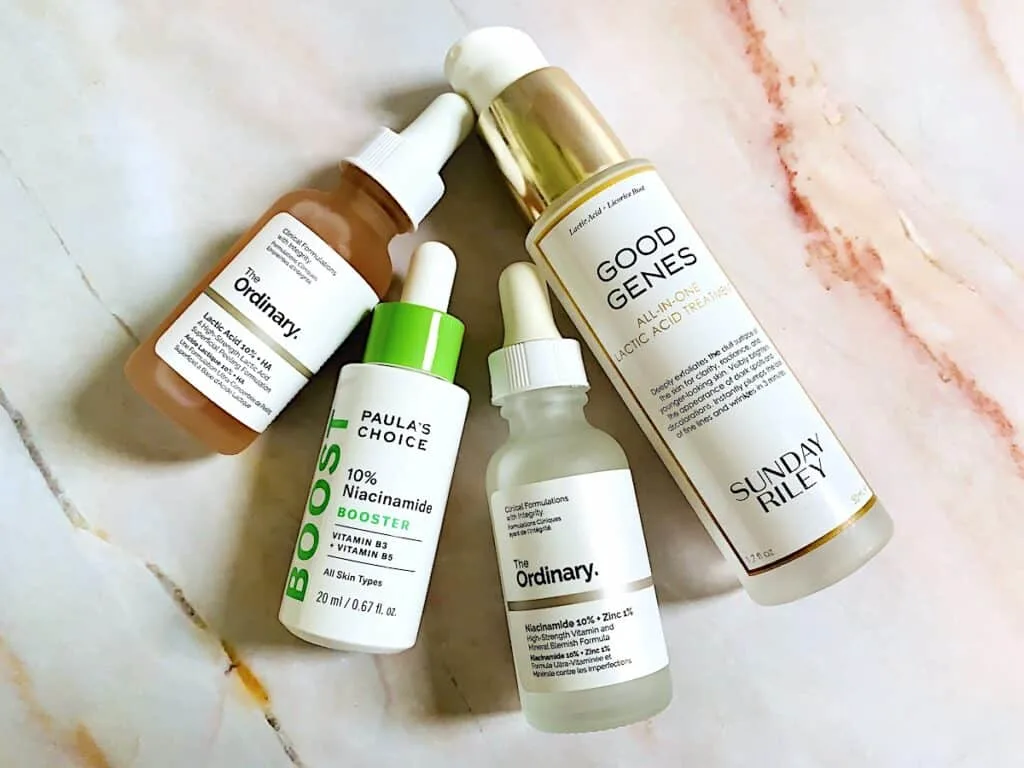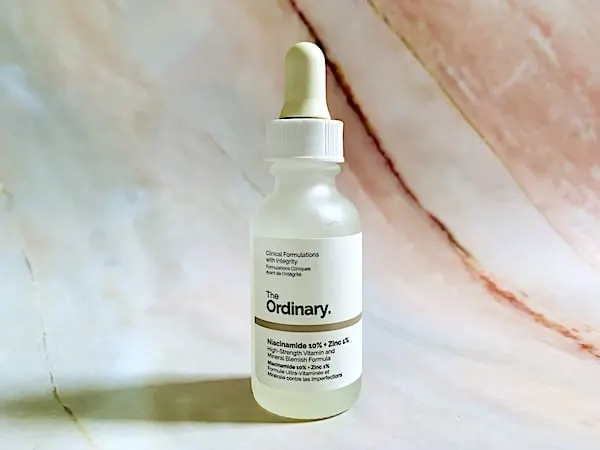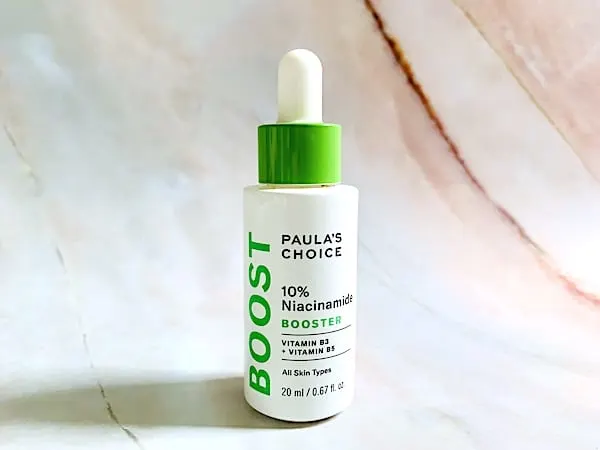They’re both great for your skin, but can you use lactic acid and niacinamide together in the same skincare routine?
Lactic acid is an alpha hydroxy acid (AHA) that exfoliates the skin to reduce signs of aging like fine lines and dark spots.
Niacinamide is a form of Vitamin B3 that helps improve the appearance of skin by reducing fine lines, wrinkles, redness, and hyperpigmentation.

The good news is that YES, you can use lactic acid and niacinamide together as part of the same skincare routine, BUT they need to be applied in a way that ensures maximum effectiveness of both products.
This requires you to wait at least 30 minutes before layering niacinamide on top of lactic acid.
The key is to make sure that you follow some basic rules in order to get the best results when using these ingredients on your skin at the same time.
Let’s take a look at why you’d want to use lactic acid and niacinamide in your skincare routine.
This post on using lactic acid and niacinamide together contains affiliate links, and any purchases made through these links will result in a commission for me at no extra cost to you. Please read my Disclosure for additional information.
The Benefits of Lactic Acid for Skin
Lactic acid is an alpha hydroxy acid (AHA) derived from milk and vegan sources like sugarcane. It works by gently exfoliating dead skin cells and increasing cell turnover.
The many benefits of lactic acid include the following:
- Lactic acid sweeps away dead skin cells, which helps to improve the look of hyperpigmentation, dark spots, and uneven skin tone and improves skin clarity.
- A 12% concentration of lactic acid has been shown to increase epidermal and dermal firmness and thickness, which can help improve the look of fine lines and wrinkles.
- Lactic acid also binds water to the skin, increasing hydration on the surface layers of the skin.
- Lactic acid has a larger molecule size than glycolic acid (another alpha hydroxy acid), which makes lactic acid less irritating and better suited for those with a more sensitive skin type.
When using lactic acid products and other AHAs, it is important to wear a broad-spectrum sunscreen with an SPF of 30 or higher, as AHAs can make your skin more sensitive to the sun.
The Benefits of Niacinamide for Skin
Niacinamide is a form of vitamin B3 that has many benefits for the skin.
- Niacinamide stimulates collagen synthesis and proteins like keratin, involucrin and filaggrin which helps to improve the look of skin firmness and skin elasticity and reduces the appearance of fine lines and wrinkles.
- If you often deal with hyperpigmentation, blotchiness, sallowness or discoloration on your face, niacinamide is a great skincare ingredient to use as it can help reduce its appearance by melanin (pigment) formation.
- Niacinamide improves skin barrier function by reducing transepidermal water loss and increasing ceramide synthesis, free fatty acids and cholesterol in the skin. A strong skin barrier helps lock moisture in and protect against environmental irritants.
- Naicinamide is an anti-inflammatory that can regulate sebum/oil production in the skin, and reduce the look of pores, making it ideal for those with oily and acne prone skin. This 8-week study found that a 4% niacinamide gel was as effective at treating acne as a 1% clindamycin gel.
- Thanks to the antioxidant benefits of niacinamide, you’re also protecting your skin from environmental stressors that cause aging over time.
- Niacinamide improves cell turnover, which supports brighter, more radiant skin.
- Niacinamide calms redness and skin irritation thanks to its anti-inflammatory benefits.
Can You Use Lactic Acid and Niacinamide Together in the Same Skincare Routine?
While niacinamide and lactic acid can be used in the same skincare routine, you need to follow certain steps to get the best results.
When combining niacinamide and lactic acid, it all comes down to pH, which measures how acidic or basic a solution is.
The pH scale runs between 0 and 14, and water is a neutral 7.0 pH. Our skin’s pH generally falls between around 4.7 – 5.75.
Exfoliating acids like lactic acid are usually formulated around a pH of 3-4, while niacinamide products typically have a pH between 5.0 and 7.0.
Since lactic acid and niacinamide have different pH ranges, you’ll need to allow some time between applying these actives if you want to use them in the same skincare routine.
How to Layer Niacinamide and Lactic Acid
If you apply a lactic acid product and follow immediately with niacinamide, the niacinamide product may increase the pH of the lactic acid product, reducing effectiveness.
You may also experience redness, irritation, or flushing of the skin.
So, what are your options?
- Use lactic acid as a chemical exfoliant first, and then apply your niacinamide serum. Wait at least 30 minutes before layering niacinamide on top of lactic acid to let the lactic acid absorb fully into the skin.
- Otherwise, consider using niacinamide in the morning and lactic acid in the evening, since lactic acid can make your skin more sensitive to the sun.
- You can also alternate days by using niacinamide one day and lactic acid the next day.
Lactic Acid and Niacinamide Products To Try
Sunday Riley Good Genes All-In-One Lactic Acid Treatment

Sunday Riley Good Genes All-In-One Lactic Acid Treatment is a best-selling lactic acid serum.
Good Genes contains purified lactic acid, which targets built-up dead skin cells and excess sebum. Excess sebum can wreak havoc on your skin by causing breakouts, blemishes, blackheads, and acne.
The formula also contains Licorice root extract (Glycyrrhiza glabra root extract) to brighten the skin and lemongrass oil, an astringent that tones the skin and imparts a fresh citrus fragrance.
Arnica and prickly pear extracts soothe the skin. Squalane moisturizes, and aloe vera calms the skin.
The serum works to reduce the look of wrinkles, lines, dark spots, irregular skin texture, and discoloration.
It plumps the appearance of fine lines in as little as 3 minutes. Use it overnight, and you’ll wake up to brighter skin with improved radiance and clarity.
Although more expensive than other serums in this post, Good Genes is a lactic acid serum that gets quick results, making it a cult-favorite in the skincare community.
The Ordinary Lactic Acid 10% + HA

The Ordinary Lactic Acid 10% + HA contains 10% lactic acid and is formulated at a pH of 3.6 – 3.8.
The serum is enriched with sodium hyaluronate crosspolymer, a cross-linked form of hyaluronic acid that forms a mesh-like film on the skin for long-lasting hydration and moisture.
This lactic acid superficial peeling formulation also contains a Tasmanian pepperberry derivative (Tasmannia Lanceolata Fruit/Leaf Extract) that is anti-inflammatory and antimicrobial.
This extract helps soothe the skin and calm irritation that can come along with AHAs like lactic acid.
This very lightweight lactic acid serum brightens and smoothes, and over time improves uneven skin tone. It is not only effective but also affordable, making it an easy addition to your skincare routine.
If your skin is too sensitive for this 10% The Ordinary lactic acid serum concentration, The Ordinary offers a 5% lactic acid serum that is more gentle on the skin.
Related Post: The Ordinary “B” Oil Review
The Ordinary Niacinamide 10% + Zinc 1%

The Ordinary Niacinamide 10% + Zinc 1% contains a 10% concentration of niacinamide and a 1% concentration of zinc salt of PCA (pyrrolidone carboxylic acid), which helps improve the visible appearance of sebum activity.
Niacinamide helps to brighten skin tone and reduce the look of blemishes and congestion in the skin. It also helps to calm redness and reduce the look of enlarged pores.
With consistent use, skin texture and clogged pores are improved. This niacinamide serum is excellent for oily skin and those prone to acne.
Like the rest of The Ordinary products, this serum is very affordable and effective.
Paula’s Choice 10% Niacinamide Booster

Paula’s Choice 10% Niacinamide Booster serum is formulated with 10% niacinamide and a host of other good-for-your-skin moisturizing ingredients.
Niacinamide targets uneven skin tone and improves the look of fine lines, skin texture, and pores.
Allantoin, panthenol, beta-glucan, and licorice root extract calm redness and irritation.
A vitamin C derivative, ascorbyl glucoside, is an antioxidant that smoothes fine lines and wrinkles, brightens uneven skin tone.
Several other antioxidants in the formula, like ubiquinone, epigallocatechin gallate, carnosine, and genistein, protect the skin from damaging free radicals triggered by environmental stressors like UV rays and pollution.
Sodium hyaluronate, a form of hyaluronic acid, hydrates, and plumps the skin. Acetyl glucosamine plays an important role in skin hydration and has wrinkle-fighting benefits.
The texture of this serum is almost water-like, which makes it easy to layer with other skincare ingredients. It absorbs quickly and works well under makeup.
What Skin Types Can Use Lactic Acid and Niacinamide?
Lactic acid and niacinamide have moisturizing benefits for normal, dehydrated, and dry skin.
Lactic acid and niacinamide help unclog pores, which is ideal for combination, oily, and acne-prone skin.
Both can usually be used on sensitive skin, too. Just be sure to patch test before applying any new product on your face for the first time.
Looking for more Korean toners? Check out these posts:
Final Thoughts on Using Lactic Acid with Niacinamide
Lactic acid and niacinamide are potent actives that deserve a spot in your skincare routine for their anti-aging benefits.
They are ideal for those dealing with wrinkles, fine lines, dullness, hyperpigmentation, dark spots, age spots, and uneven skin tone.
For best results, when applying at the same time, just be sure to follow these basic steps: apply your lactic acid serum, and then allow at least 15-30 minutes before using niacinamide.
Thanks for reading, and until next time, here’s to your good skin health!
